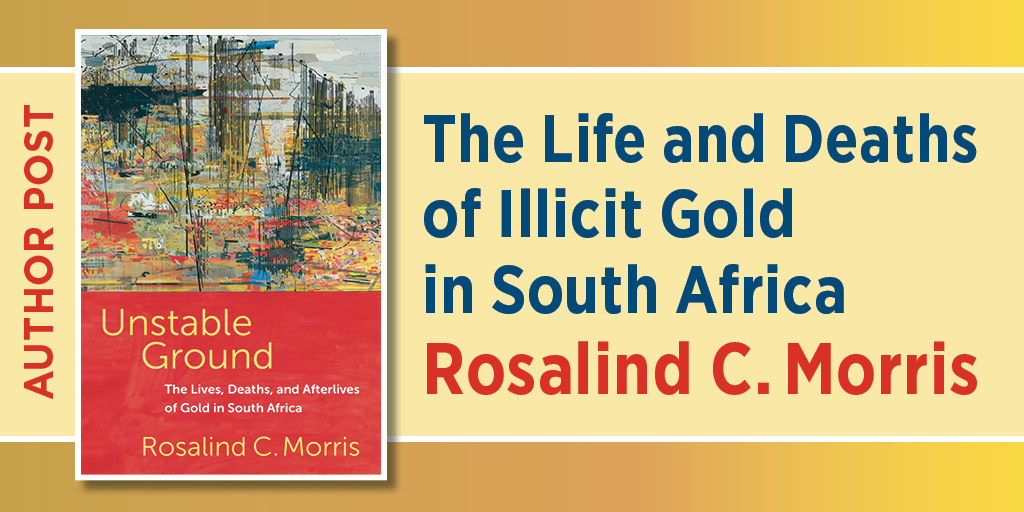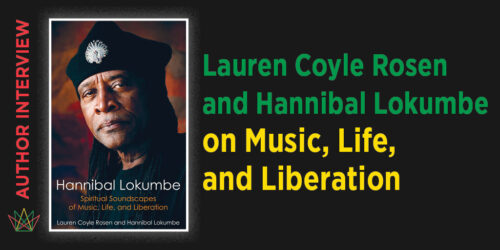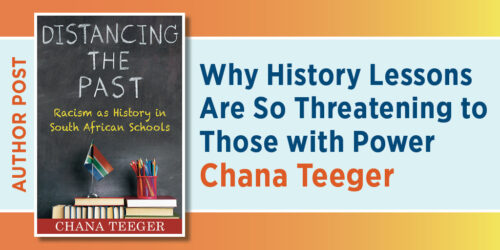The Life and Deaths of Illicit Gold in South Africa: A Global Story
Rosalind C. Morris
A Global Story
Rosalind C. Morris

Informal miners in South Africa sometimes explain an underground accident by saying that a witch has thrown death in the hole. Death emerged in mid-January, in the partially decomposed bodies of 78 informal miners brought to the surface in the town of Stilfontein. Over the previous weeks, more than 1,500 hunger-weakened miners had exited two decrepit shafts. They had been starved out by Operation Vala Umgodi—meaning ”Plug the Hole” in isiZulu—in which police cut off food and water to “smoke out” a shadow workforce.
How did this horrifying scene come to be? What is the relationship between this local catastrophe and the global economy? From what vantage point can the links between them become visible?
According to the World Gold Council (WGC), 20 percent of the world’s newly mined gold comes from small-scale and artisanal production. In a 2024 report ironically titled Silence Is Golden, the WGC notes that an astonishing 80 percent of all the people who work in the gold sector worldwide do so as informal or artisanal mineworkers, many in the shadow of the law under extremely coercive circumstances. In 2022, that meant about 20 million people were eking out a living as small-scale miners of gold (with another 20 or so million working in a similar fashion to obtain other minerals). Together, they, supported an estimated 270 million individuals.
In 2022, that meant about 20 million people were eking out a living as small-scale miners of gold.
These extraordinary numbers reflect rapid growth in recent decades. According to the WGC, the upsurge began in 1993, a year in which the price of gold was as low as it had been in over a decade. (The price of gold continued to fall until 2001, after which it proceeded on a wildly upward trend). Given that the increase in informal gold mining preceded the rise in gold prices, the profusion of informal mining might appear to be linked instead to the rise of private security forces, militias, mercenary armies, and other nonstate actors in international conflict, particularly in the aftermath of the Soviet system’s collapse—illicit arms trade does, after all, depend on untraceable cash flows and therefore on unminted gold. But this is only part of the story.
The era of globalization beginning in 1993 commenced not only with the fall of Soviet socialism but with the emergence of new regionalisms (like NAFTA and the EU), whose borders later became perimeters in the combat over migration. This was also the case in Africa. In 1992, the Southern African Development Community was formed, partly to disentangle the region’s states and economies from the soon-to-be-dismantled Apartheid regime, and partly to offset the loss of development aid that had previously come from Soviet bloc states. In fact, some of this reorientation had begun much earlier, and the area had already been affected by the efforts of South African gold mines to extruding foreign labor in the 1970s. That meant loss of wages and taxes that migrant laborers had otherwise brought home, and a growing population of the unemployed. Today, South African gold mines employ less than 10 percent the number of miners that they employed in the 1980s, when South Africa was the world’s largest gold producer.
What we see around the world today in tariff wars, isolationalist nationalisms, and the vilification of migrants can be traced back to that period, when capital began to fly around the world even as multinational corporations shed their commitments to local communities of laborers. South Africa’s mineral economy, which had been defined by the compound system, and whose black workers were heavily dependent on the corporation for social goods that the state was not providing, experienced this trend in acute ways.
Today, South African gold mines employ less than 10 percent the number of miners that they employed in the 1980s, when South Africa was the world’s largest gold producer.
Starting in the 1970 and accelerating in the 1980s. the process of extruding ”the foreign element” was described in South Africa as “stabilization.” This entailed the gradual settlement of black mineworkers near mines, and thus a partial attenuation of the carceral dynamics of the “Bantustans,” where black mineworkers had previously been forced to reside between contracts. Black mineworkers were still not permitted to choose their domicile; the Group Areas Act was still in effect. But they were no longer excluded from urban or peri-urban life.
While departing from some earlier policies, stabilization also reinvigorated elements of the Apartheid regime’s tribalist fantasy, encouraging ethnic identification and patriarchal hierarchy, which it framed as “traditional,” and reinstrumentalizing women in the service of a “restored” masculinity. The aspirations of many black workers, feminists, artists and civil society activists for broader social transformations and greater freedoms—expressed in union activism, political opposition, aesthetic invention, and popular protest—encountered numerous crises, most notably the HIV/AIDS epidemic.
The full complexity of history, as Walter Benjamin once argued, is elusive, and may perhaps best be grasped from the perspective of the ruin. But what, precisely, is in ruin? In what sense is stabilization itself a kind of ruin? And what does the recurring dream of gold as a pure store and signifier of value have to do with it all, especially in a moment when the monetary realm seems to have been almost completely digitized?
Benjamin made his claim while contemplating the arcades of nineteenth-century Paris. In their emptied halls, he found the essential forms and emblems of industrial capitalism, which was both an outgrowth of and a precursor to financial capitalism.
Although few people ever visit the depths of the world’s deepest mines, corporate advertising extends their visibility and their capacity to serve as altars for technology’s valorization and even fetishization.
Significant capital traveled to South Africa from France and Germany, as well as England, in the early days of the gold sector’s development. Nonetheless, any resemblance between the vaunted ceilings and airy spaces of the Paris arcades and the cavernous tunnels of deep industrial mines initially seems strained. And yet both are stages of display value: in Paris, the display value of the consumer commodity; in South Africa, the display value of technology.
Although few people ever visit the depths of the world’s deepest mines, corporate advertising extends their visibility and their capacity to serve as altars for technology’s valorization and even fetishization. In its fetish form, technology seems to be an answer to every question, the solution to every problem, the rationale for every political strategy. It confers power and wealth on whoever claims to invent or master it. But its dazzling light obscures the systems of value that hold people captive like the chained figures in Plato’s allegory of the cave. To see beyond that dazzling light requires thinking from the ruin.
In the ruin, the finitude of gold—and of all minerals—and the finitude of technology reveal each other. Mining technology has no value in itself; it acquires its value only in relation to the “payability” of capital-intensive extraction. This kind of capitalism is structured by contradictions, some of which can be captured by the phrase “extraction-production.” Here, construction entails destruction, and a global economy where capital and data can flow freely creates enclaves of immobility for the poorest.
In the ruin, the finitude of gold—and of all minerals—and the finitude of technology reveal each other.
History’s forms are not only architectural, of course; they are also social. In any era, they appear in the condensed figures of new social types. In nineteenth-century Paris, one such figure was the ragpicker, the urban counterpart to the gleaner, a being who found value in waste. In South Africa today, the ragpickers of the gold industry’s margins are called zama zamas. They travel the same routes that migrant laborers have traveled for more than century, compelled by poverty or by armed gangs—often both—to dig for gold in the abandoned but unsealed shafts of the approximately 6,100 closed gold mines that dot the South African landscape.
Zama zamas are not merely the scavengers of an industrial twilight, however. They also incarnate the South African industry’s original and essential elements, especially the function of waste and its valorization. Waste for mining corporations includes the tailings and slimes dumps that remain after gold has been extracted from conglomerate rock. In the industry’s early days, it also referred to workers who had become incapable of laboring due to physical debility or pulmonary ailments that arose from working underground. And it included the gold that was pirated into the illicit economy.
When South Africa’s gold mines were first established, an estimated 10–15 percent of the gold extracted was channeled into a clandestine market. As a percentage, this is not so different from the rate that today preoccupies the WGC, as well as Interpol, which classifies much informal mining as “environmental crime.” So, we may ask, what is new?
Back then, the number of workers involved in the criminalized informal underground was relatively small compared to the number of workers involved in the licit economy. Today, a much larger percentage of mineworkers belong to the (often criminalized) informal underground. In the long arc of history, there has been both a creation of a mass of laborers and a massive expulsion, a kind of wasting, of labor. At the hinge in this long process, operating the border between them, are technologies of separation. Some of these technologies are material-industrial, some are economic and sociopolitical. Among the former, the cyanide process is perhaps the most important. Among the latter, the spatializing and territorializing of gendered race and ethnicity that culminated in Apartheid have been central. Moreover, the material-industrial order provided the alibi and aesthetic idiom for the sociopolitical order, legitimating the oscillating labor migration system as the “cost” of extraction and anchoring mineral separation in social separatism.
Today, a much larger percentage of mineworkers belong to the (often criminalized) informal underground.
At the end of Apartheid, many black people hoped that the golden engine of South Africa’s economy (and before it, British imperial power) would be redeemed. They would no longer be treated as waste. But by then, the value of gold had fallen drastically, the mines had been depleted and were no longer the largest source of GDP, and the number of people employed by the mines was dropping precipitously.
“Freedom, and they closed.” That’s how one elderly man walking through the ruins of a mine compound built a century earlier described things to me. He was voicing the predicament of those who found themselves economically displaced in the very moment that they achieved formal political rights.
The old man spoke these words in the ruins of a skomplaas, one of the liminal zones where black mineworkers were permitted to reside with women. The skomplaas, a rarely discussed phenomenon in the history of “stabilization” functioned as a kind of border on the edge of mineral enclaves. It is another technology of separation. There are many.
Indeed, it may be this very separation and indeed separatism that is emblematized in the recent events at Stilfontein. Disappointed that Apartheid’s demise did not give way to the “golden future” that so many desired, and mobilized for the new nationalism that the post-Apartheid state has cultivated in its effort to escape history, many South Africans have grown hostile to foreigners. Periodic eruptions of xenophobic violence have marred recent decades.
These developments have taken very particular forms in South Africa, but neither the fact of informal mining nor the scapegoating of foreigners for the failures of the contemporary economy are unique. While informally mined gold does indeed lubricate the traffic in arms associated with privatized war and organized crime, it also enables the lives of those millions of people who live in dire poverty and who cannot access the digital credit sphere because they lack documented status or simply have “bad credit.” The underside of the financialized world, where cryptocurrency competes with the fiat money of sovereign nations, is not so much a shadow world as a domain of hard surfaces. Long after the gold standard died, gold remains a source of livelihood even when it also entails a risk of death.
Rosalind C. Morris is professor of anthropology at Columbia University, and the author of Unstable Ground: The Lives, Deaths, and Afterlives of Gold in South Africa






